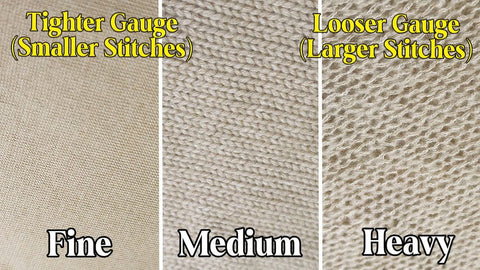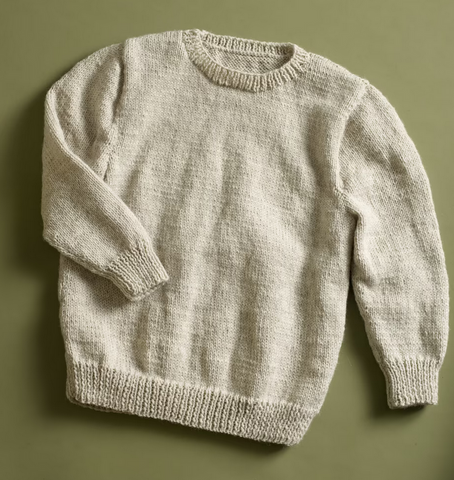Knitwear is a versatile and timeless staple in the world of fashion, offering comfort, style, and warmth in equal measure. However, navigating the world of knitwear can sometimes feel like deciphering a foreign language, with terms like GG and technical terminology leaving many scratching their heads. In this blog post, we'll demystify the jargon surrounding knitwear, focusing on GG and other technical terms to help you better understand and appreciate the artistry and craftsmanship behind your favorite knitted garments.
Understanding GG: GG, short for "Gauge" or "Gauge System," is a common term used in the knitwear industry to denote the fineness or density of a knitted fabric. It refers to the number of needles per inch on a knitting machine, with a higher GG indicating a finer and more tightly knit fabric. For example, a 12GG knit will have 12 needles per inch, resulting in a smoother and more refined texture, while a 3GG knit will have only 3 needles per inch, creating a chunkier and more substantial fabric.

GG is an important consideration in knitwear production, as it directly affects the look, feel, and performance of the finished garment. A higher GG knit tends to be lighter, softer, and more breathable, making it ideal for lightweight sweaters, tops, and dresses, while a lower GG knit offers greater warmth and durability, making it suitable for outerwear, blankets, and accessories.

The appropriate time to wear knitwear of different GG (Gauge) can vary depending on the climate, season, and personal preference. Here's a general guideline:
- Fine Gauge (12GG and higher):
- Spring and Summer: Fine gauge knits are lightweight and breathable, making them suitable for cooler spring days or summer evenings when there's a slight chill in the air. They are ideal for layering over a shirt or wearing as a standalone piece in milder weather.
- Indoor Wear: Fine gauge knits can also be worn indoors year-round, providing a comfortable and stylish option for offices, restaurants, and other indoor settings where air conditioning may be present.
- Medium Gauge (7GG to 10GG):
- Fall and Spring: Medium gauge knits strike a balance between warmth and breathability, making them perfect for transitional seasons like fall and spring. They offer enough insulation to keep you cozy on crisp mornings and evenings without feeling too heavy or bulky.
- Layering Piece: Medium gauge knits are versatile layering pieces that can be worn over a t-shirt or under a jacket for added warmth and style. They're great for creating stylish and practical outfits for unpredictable weather.
- Chunky Gauge (3GG to 5GG):
- Winter: Chunky gauge knits are the heavyweights of knitwear, providing maximum warmth and insulation. They're perfect for cold winter days when you need to bundle up against the elements and stay cozy and comfortable.
- Outdoor Activities: Chunky gauge knits are ideal for outdoor activities like skiing, snowboarding, or hiking, where staying warm is a top priority. They're also great for lounging at home or enjoying a fireside gathering with friends and family.
Ultimately, the best time to wear knitwear of a particular gauge depends on your local climate, personal style preferences, and the specific occasion or activity. Whether you prefer fine, medium, or chunky gauge knits, there's a perfect option for every season and situation.

Other Technical Terms in Knitwear: In addition to GG, there are several other technical terms commonly used in the knitwear industry that are worth knowing:
- Stitch: The basic unit of a knitted fabric, formed by interlocking loops of yarn.
- Yarn Weight: Refers to the thickness or diameter of the yarn used in knitting, typically categorized into categories such as lace, fingering, sport, worsted, and bulky.
- Ribbing: A textured pattern created by alternating knit and purl stitches, commonly used for cuffs, collars, and hemlines to provide stretch and structure.
- Cable: A decorative pattern created by crossing stitches over each other to form twists or braids, often seen in sweaters, scarves, and blankets.
- Intarsia: A colorwork technique where different colored yarns are used to create intricate patterns or motifs within a knitted fabric.
- Fair Isle: A traditional knitting technique originating from the Fair Isle in Scotland, characterized by intricate colorwork patterns and motifs inspired by nature and folklore.
Understanding the technical terms and terminology used in knitwear can help you appreciate the artistry and craftsmanship behind your favorite knitted garments. Whether you're shopping for a lightweight sweater for spring or a cozy blanket for winter, knowing the difference between GG, stitches, yarn weights, and other technical terms can empower you to make informed choices and find the perfect knitwear pieces to suit your style and needs. So the next time you slip on a knitted sweater or wrap yourself in a cozy blanket, take a moment to appreciate the skill and expertise that went into creating it.
MORE LUV.
